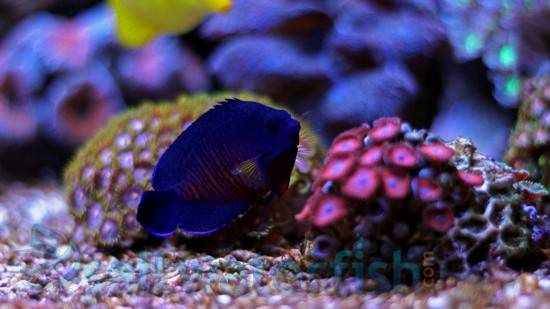Colored Toadfish
Halophryne sp.
(0 Reviews)

Colored Toadfish
Halophryne sp.
(0 Reviews)
{{ item.name }}
Size: {{ item.extra_field_3 }}
${{ getFormattedPrice(item.saleprice) }} ${{ getFormattedPrice(item.price) }}
To join the waiting list, click here
Free Shipping
With
$199.00
or more in Marine Life.
More details...
Colored Toadfish Care Facts
| Care Level: | Easy |
|---|---|
| Temperament: | Aggressive |
| Diet: | Carnivore |
| Reef Safe: | No |
| Minimum Tank Size: | 100 Gallons |
| Max Size: | 12 inches |
The Toadfish, Halophryne sp., hails from the waters of the Gulf of Mexico and ranges from brown, red and orange colorations. It is a bottom dwelling predator that seeks out small fish and inverts. It is best kept in a large aquarium void of these small organisms. With such a large mouth and appetite, the Toadfish can make many small organisms prey; therefore, they should not be housed with smaller reef fish, such as some anthias and cardinals. They are hardy and can handle large fluctuations in water parameters.
Colored Toadfish (Halophryne sp.): A Captivating Addition to Your Marine Aquarium
The Colored Toadfish, scientifically known as Halophryne sp., is a captivating addition to the world of saltwater marine aquariums. This comprehensive product description will provide you with essential information to help you decide if this unique species is the right choice for your marine tank. We'll delve into habitat, reef compatibility, size, lifespan, diet, aquaculture availability, compatibility with other marine life, sexual dimorphism, coloration changes from juvenile to adult, temperament, tank requirements, and water conditions. Moreover, we will also discuss common names and suggest compatible tank mates.
Habitat: Thriving in Tropical Marine Environments
Colored Toadfish are native to tropical marine environments, typically found in the Indo-Pacific region. They inhabit shallow waters, including coral reefs and rocky substrates. These fish are adapted to a benthic lifestyle, meaning they prefer to dwell near the bottom of the ocean, often concealed among crevices and coral formations.
Reef Compatibility: Noteworthy Characteristics
While the Colored Toadfish is a captivating species, it is not considered reef-safe. They have a penchant for munching on small invertebrates and crustaceans that may coexist in reef ecosystems. Therefore, keeping them in a dedicated aquarium without corals and other sensitive reef organisms is best.
Size and Lifespan: Small Marvels for Long-Term Enjoyment
Colored Toadfish are mid sized, typically reaching a maximum length of 10-12 inches. In captivity, they can live for an average of 5-10 years with proper care.
Diet in Captivity: A Hearty Appetite for Meaty Foods
These fish are predatory by nature and have a hearty appetite for meaty foods. In captivity, they readily accept a diet of live or frozen foods such as small crustaceans, brine shrimp, and finely chopped seafood. Offering a varied diet is essential to ensure their nutritional needs are met.
Aquaculture and Availability: Rarity in the Aquarium Trade
Colored Toadfish are not commonly aquacultured, making them relatively rare in the aquarium trade. However, availability may have changed since then, so it's best to check with reputable saltwater aquarium suppliers, such as saltwaterfish.com for the most up-to-date information.
Compatibility with Other Fish and Invertebrates: Choosing Suitable Tank Mates
Colored Toadfish are generally peaceful with most medium to large fish species but may exhibit territorial behavior. When considering tank mates, choose species of similar size and temperament. Avoid housing them with small, delicate fish and invertebrates, as they may be seen as potential prey.
Sexual Dimorphism: Observing Subtle Differences
Sexual dimorphism in Colored Toadfish is not readily observable without close examination. Both males and females share similar physical characteristics and coloration.
Juvenile to Adult Coloration Changes: A Striking Transformation
Colored Toadfish display a striking transformation in coloration as they mature. Juveniles often sport vibrant red, orange, and yellow hues, while adults develop more subdued color patterns dominated by shades of brown and gray.
Temperament: Calm and Non-Aggressive Companions
These Toadfish are generally calm and non-aggressive, making them suitable for community aquariums with the right tank mates. However, continually monitor their interactions to ensure harmony in your aquatic ecosystem.
Tank Requirements: Creating a Comfortable Habitat
Minimum Aquarium Size: A suitable tank for Colored Toadfish should be a minimum of 100 gallons. Provide ample hiding spots among rocks and crevices to mimic their natural habitat.
Water Conditions:
pH: Maintain a stable pH level between 8.1 and 8.4.
Salinity: Keep the salinity within the range of 1.020-1.025.
Water Temperature: Maintain a temperature of 72-78°F (22-26°C).
Water Flow: Moderate water flow is suitable, but avoid strong currents.
Common Names: Recognizing the Colored Toadfish
Colored Toadfish may also be known by various names, including Painted Toadfish, Splendid Toadfish, and Colorful Toadfish.
Compatible Tank Mates: Harmonious Companions
Here are five compatible tank mates to consider:
- Saddleback Clownfish (Amphiprion polymnus)
- Blue Hippo Tang (Paracanthurus hepatus)
- Copperband Butterfly (Chelmon rostratus)
- Coral Beauty Angelfish (Centropyge bispinosus)
- Marine Betta (Calloplesiops altivelis)
Why Choose Colored Toadfish from Saltwaterfish.com: Quality, Expertise, and Selection
Saltwaterfish.com is your trusted source for obtaining Colored Toadfish for your aquarium. We take pride in providing our customers with healthy, responsibly sourced marine life. Our team of experts ensures that each fish is carefully selected and maintained in optimal conditions before reaching your doorstep. By choosing Colored Toadfish from Saltwaterfish.com, you are adding a unique and captivating species to your aquarium and supporting ethical and sustainable practices in the marine aquarium industry.
Currently Colored Toadfish does not have any reviews.















